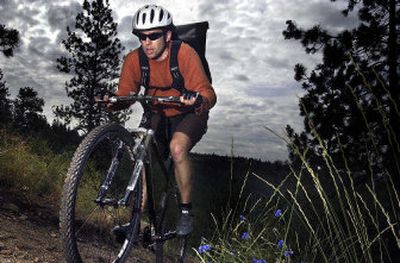One nutty way to exercise

Something’s always cooking with David Blaine, or at least the wheels are always turning.
The 35-year-old gourmet chef at the Latah Bistro is among the region’s standouts in endurance bicycle racing, a sport he’s mastered with a hobo stew of unconventional techniques.
“I compete in 24-hour races with other mountain bikes, but I do it on a single-speed,” he said.
And he has a list of half-baked events and projects that rank him among the more delicious stories in local cycling.
Before you write him off as a showboat, consider his explanations:
“Why 24-hour races? “Because I’m not very fast, but I like to be competitive, and I get more competitive after 5 or 6 hours.”
“Why not a multi-speed mountain bike? “Because I’m a really terrible mechanic. I’m probably not even qualified to work on single speed bike. My tool kit consists of sticks and rocks.”
Blaine has had lifelong fascination with bikes, but he didn’t discover his aptitude for distance until six years ago. He felt so good after riding the Spokane Bicycle Club’s non-competitive 100-mile Autumn Century, he decided to tackle a real test.
“That was right about the time 24-hour endurance racing was catching on,” he said. “I entered the solo division of the 24-hour race at Riverside State Park and made 157 miles on a geared mountain bike.”
Six years later, he holds the record for the most solo finishes in the rugged Round the Clock Race at Riverside and his best 24-hour performance is 254 miles on a single-speed bike he works up steep hills with body English rather than a multitude of sprockets.
Placing second in the single-speed class of this year’s Round the Clock Ride was a special achievement, considering the soaring daytime temperatures over the Memorial Day weekend.
“The heat was bad, and five of the top riders in the world had scratched by midnight,” he said. “It was a trail of devastation. Chris Eatough – some call him the Lance Armstrong of mountain bike endurance racing because he had five consecutive world championships – was lying on the side of the trail with leg cramps.
“I survived by going a lot slower than most of them. That’s the mantra of endurance racing, struggling through all these problems.”
Blaine has a complex nutritional regimen for 24-hour racing that hinges on happiness.
“I do chocolate and coffee and astronaut food at the beginning, but later I lean toward Nutter Butter cookies and gummy bears. In the end, it’s not the physical challenge, it’s staying in a good mood.”
Blaine says his greatest achievement has been qualifying for the 24-hour World Championships last fall at Whistler, British Columbia.
“I finished fourth in the single-speed category, but I’m more proud of finishing 40th out of 168 starters, including riders with gears. Everybody had to qualify to be there and the riders came from seven or eight countries. It’s the closest I’ll ever get to competing in an Olympic-caliber event.”
Blaine does most of his training at night, which is not outlandish considering most of his races involve night riding. Moreover, he’s usually too wound up to sleep right after a night of crushing garlic and doing magic with flames, spices and killer deserts at one of Spokane’s trendy eateries.
“I invite people to do a Moonlight Century with me each summer, and it’s cool that people do it even if they don’t plan to ride the entire 100 miles,” he said.
“The great thing about doing a century at night is that just at the point you’re hitting the hardest part of ride, you’re four hours into it and getting pretty tired, that’s when the light starts showing in the east, and the birds start chirping.
“You get a boost from the sun coming up. Anybody who’s done ultra-endurance events will tell you it’s impossible to feel tired at sunrise. There’s a renewal there.
“If you have the proper reflectors, clothing and lighting, it’s probably safer to ride at night than during day.”
Even the mundane becomes a marathon in Blaine’s world of goals, which include a plan to set a endurance record and maybe make an informal race out of riding Washington’s rail-trails 210 miles from Easton to Tekoa.
He also is trying to complete what he calls the Spokane Unabridged Project.
“I want to ride every street in the city,” he said.
“I’ve biked here for years and I have my favorite routes, mostly designed to keep me away from tricky traffic situations. I have a high tolerance for repetitiveness.
“But a few years ago, I said I need to come up with new routes. I bought an atlas of the city streets and that evolved into something bigger as I used a highlighter to mark off each street I’d ridden.
“The byproduct is discovering a whole bunch of new roads as well as interesting homes, neighborhoods and side streets that I’ve missed for all these years.”
Indeed, the more he rides, the more reasons he finds to keep riding. Even loose dogs aren’t a deterrent.
“In fact some of us consider them training buddies because they’re a good incentive for a sprint.”